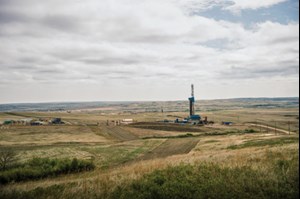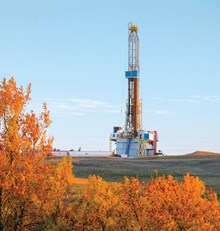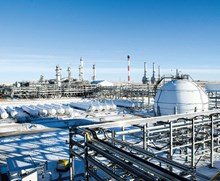Shaletech: Bakken/Three Forks Shale For now, bust-to-boom mentality grips Williston basin
In keeping with agrarian counsel that holds one should “make hay while the sun shines,” operators in the price-sensitive Bakken shale are pouncing on higher oil prices, abetted with near-inconsequential differentials, to lift production to a three-year high.

Largely abandoned when crude prices cratered, with a low of 22 active rigs during the week of May 27, 2016, the Bakken and similarly productive Three Forks shales are “back in-the-money,” as Bloomberg reported on May 7, so much so that the “B” word has returned to the North Dakota conversation. “I suspect many of you have seen recent articles that say the Bakken is back, or the Bakken is booming again. Well, I couldn’t agree more,” Jack Stark, president of premier leaseholder Continental Resources, Inc., told analysts on May 3. “Bakken wells across the field are producing at unprecedented levels, uplifting the economics of the entire field.”
The North Dakota epicenter of the mature Bakken and underlying Three Forks shales, deposited throughout the Williston basin and stretching into Canada, has, indeed, become a go-to play for operators priced out of the high-octane Permian basin. Exploiting well-known rock, long-entrenched operators are focusing on clearly delineated core assets, with contemporary wells featuring supersized completions and, according to preliminary first-quarter data from myriad U.S. plays, a higher per-capita share of laterals extending beyond 11,000 ft. “The mature Bakken exhibits a shift towards laterals even longer than two miles since the second quarter of 2017,” Rystad Energy concluded in its “Shale Trends Report” released in April.
XTO Energy is listed among the extended-reach leaders, with Bakken laterals pushing three miles (15,840 ft). At last count, the company was running four rigs on a 486,000-acre leasehold, where it reportedly intends to double oil production to around 200,000 bpd over the next two years. “When I first started getting associated with the Bakken, a good well was 600-700 bpd, and now we’re routinely over 2,000 bpd, initial rate,” Jack Williams, senior vice president of XTO parent ExxonMobil, said on March 7 during the 2018 analysts meeting.

Those high-flowing wells are expected to collectively produce 1.238 MMbopd in June, up from the 1.039 MMbopd that went online in June 2017 (Fig.1), according to the U.S. Energy Information Administration (EIA). Forecasted June oil production falls just short of the most recent high of 1.266 MMbopd that the EIA reported in June 2015. Associated gas production is estimated to reach 2.277 Bcfd in June, a year-over-year increase from 1.798 Bcfd.

Similarly, Baker Hughes says the Williston basin averaged 57 active rigs in May, compared to a 44-rig average in the same month of last year, Fig. 2.
Providing more heft to improving oil prices, the once notoriously high double-digit differentials relative to the West Texas Intermediate (WTI) benchmark have shrunk, in some cases, to below $3/bbl, thanks in no small part to activists’ failure to torpedo the Dakota Access oil pipeline and its eventual 570,000-bpd capacity. The network, which has been in service for a year (as of this month), with current capacity of approximately 470,000 bopd, has taken much of the load off once rail-dominated transport. “We think there’s adequate takeaway capacity from the basin right now,” said Peter Hagist, senior vice president of planning for high-flying Whiting Petroleum Corp., which has seen differentials decline 72% since 2014, now averaging $3.02/bbl.
The ill-famed price sensitivity of the Bakken, however, provides a cautionary tale, as activity levels historically have been exceptionally vulnerable to any downward shift in commodity prices. Moreover, out-of-compliance operators face a day of reckoning later this year, when tighter regulations aimed at reducing gas flaring take effect.
TOUGHER GAS RULES
In November, operators in the Bakken-Three Forks core must prove they are capturing no less than 88% of associated gas, an increase from the 85% gas capture rate the North Dakota Industrial Commission currently requires. Operators found not in compliance face the risk of oil production curtailments.

Most contend that they are well within the new rules, with Whiting Petroleum and Oasis Petroleum Inc. among those reporting 90% gas capture rates. Hess Corp., for its part, says between the existing Tioga Gas Plant and a planned 100-MMcfd newbuild processing facility, it is more than equipped to handle tighter gas capture rules, Fig.3. First-quarter gas processing volumes averaged 214 MMcfd, well below current Tioga capacity of 250 MMcfd.
Meanwhile, after drilling 23 wells and turning 13 in-line during the first quarter, Hess plans to increase from four to six rigs over the second half of the year. At 554,000 net acres, the company’s largest operated asset produced 111,000 boed during the first three months of 2018, with guidance calling for year-end production of 115,000 to 120,000 boed.
Unlike the Permian basin, the Bakken growth spurt has not come with significant inflationary pressure, said COO Greg Hill. “If you look at the rate of growth of rigs in the Bakken, it’s much smaller than it is in the Permian. It’s kind of onesie, twosie; people growing by one or two rigs. So, the rate of increase is not substantial.”
Meanwhile, to help avoid any Permian-like supply constraints, Smart Sand, Inc., of The Woodlands, Texas, invested $15.5 million, mostly to acquire rights to a transloading train terminal in Van Hook, N.D. Since April, the repurposed terminal has been handling the delivery of Northern White frac sand from the company’s newly expanded Oakdale, Wis., mining operation.
MAKING HAY
Whiting Petroleum likely will consume a significant portion of the added supply, as it accelerates the transition to a Bakken-centered operator. Whiting added a fifth rig in April, with plans to drill 120 gross Bakken/Three Forks wells this year across a 409,593-net-acre leasehold. After averaging production of 103,115 boed in the first quarter, Whiting also plans to run between two and four completion crews and place 123 gross wells on production this year.
In an early second-quarter completion trial in the southern Hidden Bench area of McKenzie County, a 40-stage well, stimulated with proppant loading of 8.7 million lb, tested at a 24-hr initial production (IP) rate of 4,837 boed. By comparison, wells on an offset Middle Bakken/Three Forks pad, which were completed in 30 stages with 3.8 million lb of proppant, had delivered 24-hr IP of 2,647 boed. “We have several large pads being completed in the second quarter that will come on production in the third quarter,” said President and CEO Brad Holly.
After completing 31 wells in the first quarter, Bakken pioneer Continental Resources plans to operate six rigs and up to eight stimulation spreads throughout 2018. First-quarter production from the commanding 796,000 net acres that Continental controls averaged 161,356 boed, with gas capture averaging 89%.
Continental says three of the newly completed wells rank in the top five of the company’s all-time Bakken producers, with 30-day production averaging 2,305 boed. “In fact, eight of Continental’s best 30-day-rate Bakken wells have been completed in the last two quarters.
Elsewhere Oasis Petroleum will run up to five rigs this year to drill and complete between 100 and 110 gross operated wells. Oasis’ 503,000 net acres delivered 73,200 boed in the first quarter, with 16 gross (10.2 net) wells put onstream. The company will spend $700 million to $730 million on Williston E&P, representing 85% of its 2018 capital budget.
With wellhead breakeven prices below $45/bbl, Oasis says average 10,000-ft lateral Bakken wells with 10 million lb proppant, and Three Forks wells completed with 4 million lb sand loading, come in at $7.7 million and $6.6 million, respectively.
Record basin wells on Marathon Oil Corp’s 175,000-net-acre position contributed heavily to first-quarter production of 74,000 boed, up 7% from the 69,000 boed delivered in the prior quarter. The company said two new oil wells in the West Myrmidon asset in McKenzie County averaged record Middle Bakken 30-day IP rates of 3,470 bopd. A well in the Dunn County Hector asset set a Three Forks 30-day IP record of 3,040 bopd.
These were among the 11 gross operated wells that Marathon brought to sales in the first quarter, six of which were in the core Hector area with average, 30-day IP rates of 2,600 boed (81% oil). While 30-day production rates were unavailable as of May 3, Marathon said two West Myrmidon wells that came online late in the quarter, demonstrated Middle Bakken and Three Forks 24-hr IP rates of 10,875 boed and 7,570 boed, respectively. Between 60 and 80 gross operated wells will be put online this year, mostly in the well-defined Myrmidon development.
In a sampling of other activity:
Operating a one-rig program, Newfield Exploration Co. says it has managed to whittle down the costs of 10,000-ft lateral Bakken wells with increased proppant and fluid loadings to around $5.7 million/well. Newfield turned four operated wells online in the first quarter at average gross perforated intervals (GPI) of 10,138 ft. First-quarter production from the company’s 82,000-net-acre position was 20,400 boed.
After battling severe winter weather, WPX Energy, Inc., managed to put its seven-well Arikara pad in Mountrail County, N.D., on production in March. Once online, the largest pad in the company’s history went on to deliver cumulative 30-day production of 406,000 boe, despite being choked back considerably because of winter road takeaway restrictions.
The nearly 50-day delay in Arikara first oil notwithstanding, WPX averaged first-quarter production of 39,500 boed, up 34% year-over-year. The company added a third rig in April on its 85,000-net-acre leasehold, where nearly all wells are being drilled with minimum 10,000-ft lateral reaches. “Everything is essentially blocked up as two-mile laterals. It’s almost been an exception to the rule–a rare exception–when we would find that we need to drill one mile,” said President and COO Clay M. Gaspar.
EOG Resources, Inc., drilled four wells in the first quarter, but has deferred completions until later in 2018. The company plans to operate one rig this year and complete 20 net wells, compared to 35 completions in 2017. EOG, which controls 120,000 net acres in the Bakken/Three Forks core, has set a completed well cost target this year of $4.6 million for 8,400-ft lateral wells at 650-ft spacing.
Norway’s former Statoil ASA, officially re-branded as Equinor ASA on May 15, says approximately $1 billion of the recent $1.3-billion impairment reversal is directly attributed to “underlying improvements” in its Bakken asset, with the rest attributed to U.S. tax cuts. Equinor is running a single rig on a 235,000-net-acre Bakken/Three Forks leasehold, which produced 57,000 boed at year-end 2017, according to federal filings.
ASSET RECAP
While the Bakken has not attracted a flurry of acquisitions, Comstock Resources, Inc., grabbed a foothold in May, courtesy of Jerry Jones, the flamboyant owner of the Dallas Cowboys professional football team. Comstock acquired interest in 332 gross producing wells in North Dakota in exchange for forking over $620 million worth of its stock to Jones’ Arkoma Drilling L.P., which now holds an 84% stake in the Frisco, Texas operator.
The transaction gives Comstock 52.5 net producing wells in the Bakken, along with interest in 128 gross (13 net) DUC wells and 10 gross (3 net) undrilled locations. The acquired properties are currently producing 10,500 bopd and 20 MMcfgd.
Also in May, SM Energy, Inc., hit a snag in its plans to shed some 119,415 net acres in Divide County and focus squarely on Permian basin and South Texas Eagle Ford holdings. Disappointing offers forced the Denver operator to “postpone indefinitely” the sale of Bakken assets, which delivered net production of 6,100 boed in December.
Conversely, privately held Vitesse Energy LLC. paid an institutional seller $190 million in April to buy 23,000 largely undeveloped net acres in the Bakken fairway. The non-operated assets currently average production of 4,200 boed, with 85% of the acquired properties remaining to be developed.
In early April, Canada’s PetroShale Inc. completed a $17.8-million acquisition of an undisclosed number of acres in its upper tier South Berthold area. The pure play Calgary-based independent completed four net operated wells and participated in four net non-operated wells in the first quarter, more than doubling production to roughly 5,300 boed in March, compared to the 2,121 boed produced in the final 2017 quarter. The company plans to drill nine gross (5.3 net) wells in the second half of 2018.
Whiting Petroleum, meanwhile, remains on the lookout for any bolt-on opportunities to expand its leasehold. “We have said that we are totally focused on the Bakken, and it is our job to look for any potential opportunities out there that fit into Whiting’s portfolio,” CEO Holly says. ![]()



